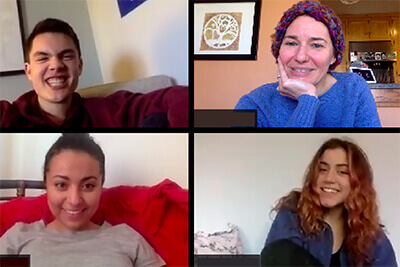March 26, 2020
 by Dr. Bill Hudson, head of school
by Dr. Bill Hudson, head of school
Great teachers make great online teachers. By now, you’ve read or heard me say that repeatedly over the last several weeks. To be honest, other than a few scattered snow days over the last several years, my assertion was more conjecture than evidentiary. However, after several days this week, I know this to be true. Because I know each teacher well, I knew in my heart but I now have proof that MPA teachers are great no matter the platform or medium.
It has been an incredible experience, working together with teachers, staff, and administration, to make the transition to virtual school. Through caffeine, adrenaline, and sheer will, we powered through to rise to the new challenge before us without doubt or hesitation. Frankly, there has never been another option. I didn’t realize this until I received a parent email with the following observation: “In corporate terms, this scale of change would have been vetted and pressure-tested through strategic planning process over a period of months, perhaps a full year’s planning cycle.” The can-do spirit of MPA has inspired us all.
The quality of teaching and learning, though different, has been exceptional. Both our mission and core values are evident in how teachers are crafting their lessons. Great teachers are great online teachers because they know that quality teaching involves differentiation, individualization, and personalization. Because of our small class size and close-knit community, teachers truly know their students and their needs, and are able to utilize that knowledge in designing their online lessons. In PreK, students made boats out of tin foil and then had to estimate and record how many pennies, nickels, or anything of their choosing, it would take to sink their boat. The next step was actually doing the experiment and counting how many items it took to sink the boat. Students then documented both the estimation and their actual finding.
Teachers are infusing joy throughout, being attentive to the social and emotional needs of students and providing time for students to interact with one another. As I sit in the other room, I hear my eighth-grade daughter laugh out loud and hear tell-tale signs of engagement. After social studies class, she remarked, “That was really fun!” I’ve also overheard Dr. Milam give her lunch announcements via Zoom, connecting with students and providing guidance about how to take care of themselves. Teachers and staff, too, are getting into the fun. Yesterday, Ms. McFarland invited employees to a lunchtime dance party that I participated in with my colleagues.
Disruption and discomfort are the enemies of complacency and can spur personal and professional growth. This crisis is pushing all of us out of our comfort zones, as parents, workers, teachers, and learners. At MPA, disruption has fueled innovation and while I have always known MPA teachers to be creative and passionate, the last few days have confirmed that belief. The lessons, activities, projects teachers have developed are remarkable. For instance, the Upper School chemistry class conducted an experiment looking at the radioactive isotopes and the half-lives of the made up element of “coinium”. They were asked to shake pennies to see how much “headsium” and “tailsium” decay is measured.
As we move forward, now more than ever we will need to lean into our core learning values, to be intentional in how we set up students to pursue learning, and—of equal importance—to be flexible in our expectations and in our learning paths. We must also infuse joy, another MPA core value, into learning. There will be tough times ahead. Fatigue will set in and the social isolation will take its toll. However, as we as a society work to “flatten the curve,” we at MPA are working hard to accentuate the peaks and smooth over the low points.